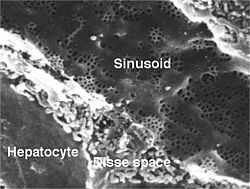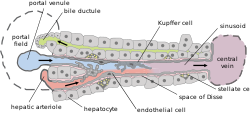| Perisinusoidal space | |
|---|---|
 | |
 Basic liver structure | |
| Details | |
| Location | Liver |
| Identifiers | |
| Latin | spatium perisinusoideum |
| TH | H3.04.05.0.00012 |
| Anatomical terms of microanatomy | |
The perisinusoidal space (or space of Disse) is a space between a hepatocyte, and a sinusoid in the liver. It contains the blood plasma. Microvilli of hepatocytes extend into this space, allowing proteins and other plasma components from the sinusoids to be absorbed by the hepatocytes. Fenestration and discontinuity of the endothelium facilitates this transport.[1] The perisinusoidal space also contains hepatic stellate cells (also known as Ito cells), which store fat or fat soluble vitamins including vitamin A).[citation needed]
This space may be obliterated in liver disease, leading to decreased uptake by hepatocytes of nutrients and wastes such as bilirubin.
The Space of Disse is named for the German anatomist Joseph Disse (1852–1912).[2]
- ^ Robbins, Stanley L.; Cotran, Ramzi S.; Kumar, Vinay; Collins, Tucker (1999). Robbins pathologic basis of disease. Philadelphia: Saunders. ISBN 0-7216-7335-X.
- ^ Haubrich WS (2004). "Disse of the space of Disse". Gastroenterology. 127 (6): 1684. doi:10.1053/j.gastro.2004.10.021. PMID 15578505.